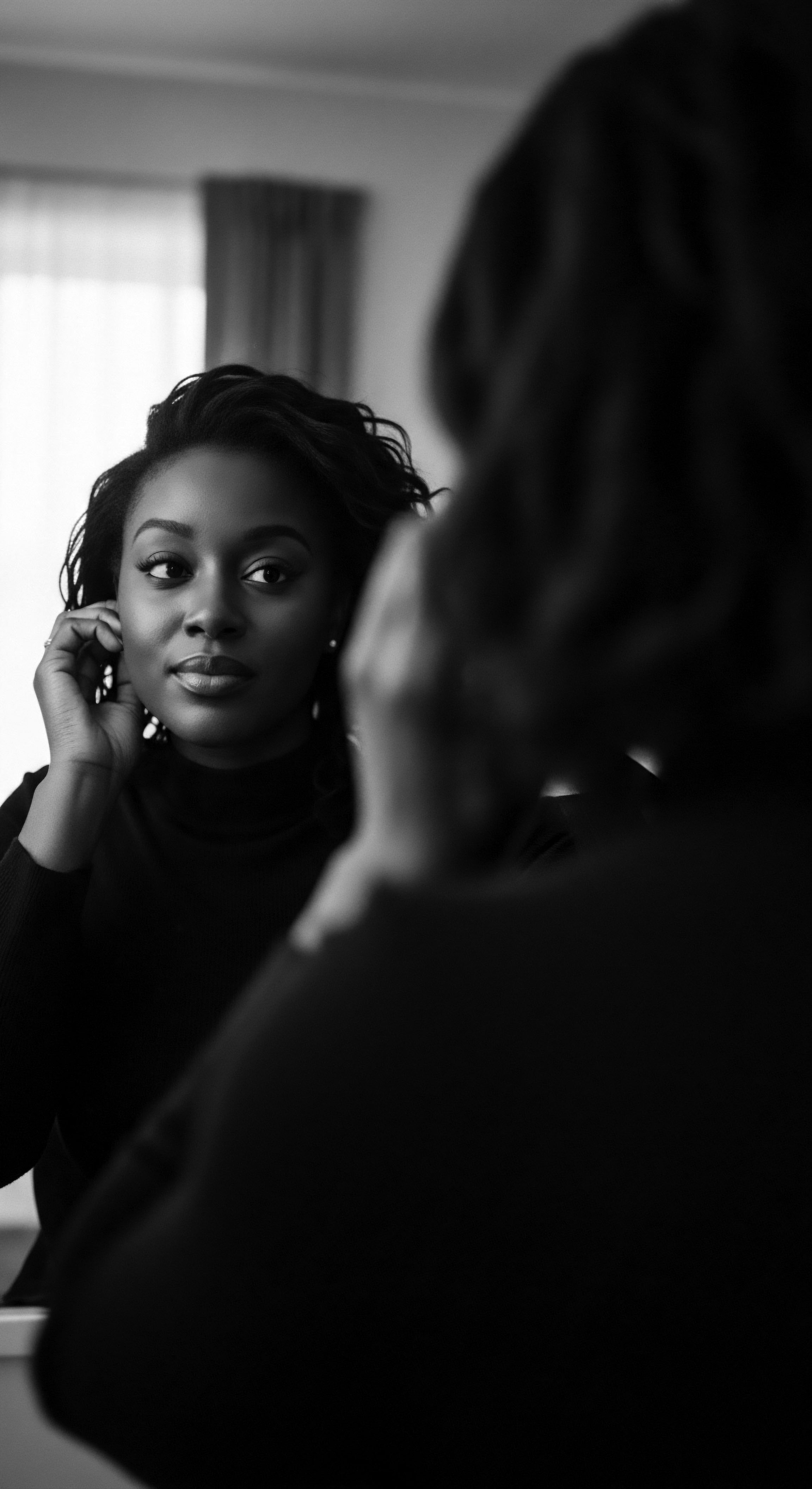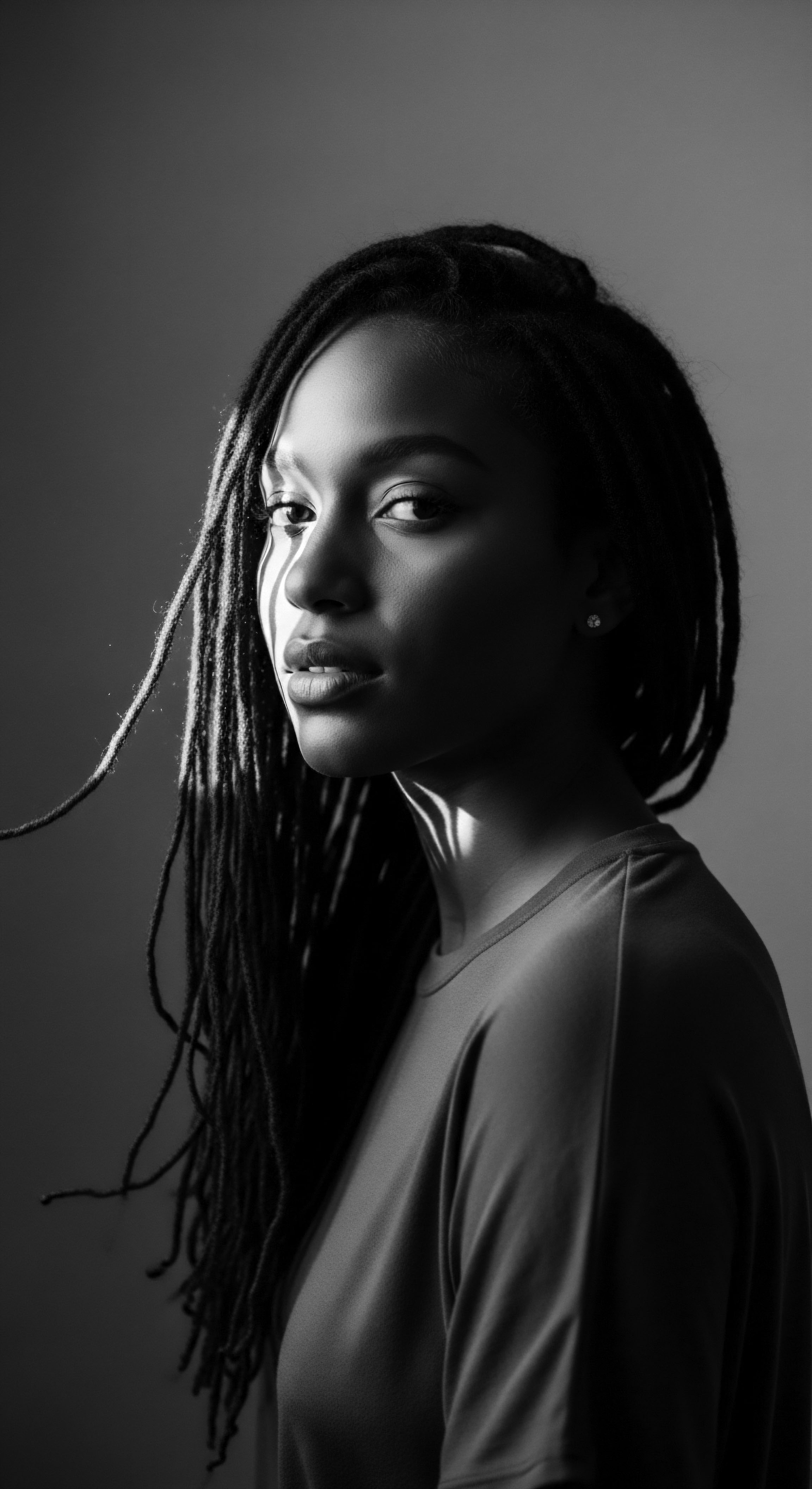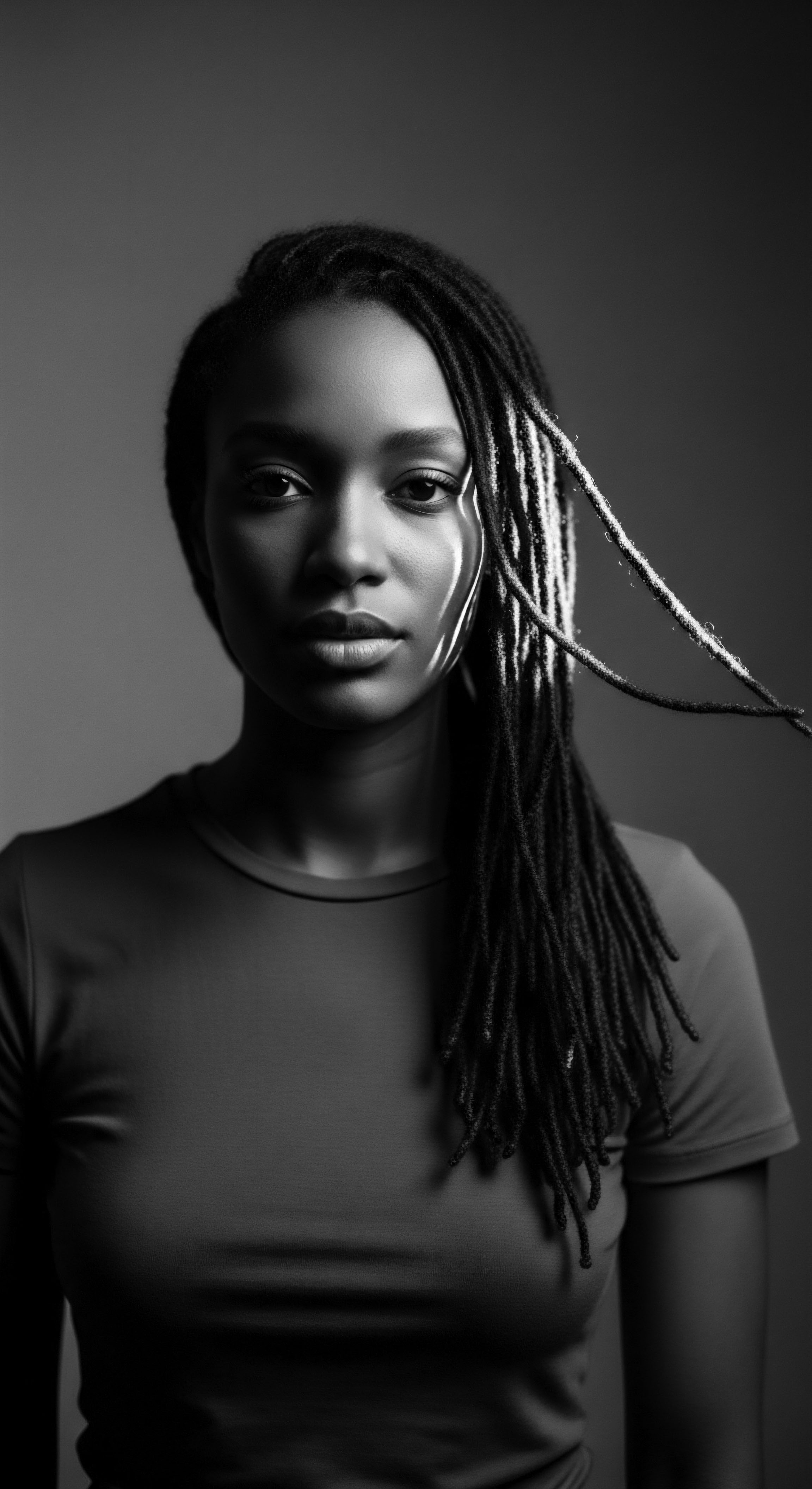
Fundamentals
The concept of Psychological Adjustment, when viewed through the lens of textured hair heritage, signifies the intricate mental, emotional, and social processes by which individuals, particularly those of Black and mixed-race descent, adapt to their experiences with hair. This includes internal comfort with one’s inherent hair structure, and external responses to societal perceptions, historical mandates, and communal practices surrounding their strands. It speaks to the journey of finding inner equilibrium in how one perceives, presents, and cares for their hair, recognizing it as a profound extension of self and ancestry. This initial understanding reveals how hair, beyond its biological presence, shapes our cognitive and affective landscapes.
Our hair, often regarded as a mere aesthetic element, assumes a deeply personal and culturally charged role, especially for Black heritage communities. Each curl, kink, and coil possesses a narrative. Hair serves as a living archive of identity, culture, and resilience (Maharaj, 2025). From traditional African styles denoting tribal affiliation and status, to the politicization of natural hair in the 1960s as a display of self-acceptance and protest, hair carries historical weight.
Navigating this inheritance within societies shaped by Eurocentric beauty standards often carries a significant emotional cost. Many individuals of Black heritage frequently encounter notions that their natural texture appears “unprofessional,” “messy,” or even “unclean” (Maharaj, 2025). These directives, whether encountered in academic spaces, professional settings, or media representations, extend beyond simple aesthetic preferences. They bear directly upon feelings of belonging and self-worth.
The psychological impact of these experiences is often deep and unspoken. Constant small acts of aggression directed at hair contribute to this burden. Research and community discussions reveal several mental consequences of hair-based stigma. These include an internalization of racial biases, leading to a negative self-perception, a heightened state of anxiety, and constant vigilance regarding how others perceive one’s hair.
Chronic stress in educational or occupational environments frequently results, along with feelings of cultural disconnection. The emotional cost can manifest as grief and sadness arising from hair loss linked to illness or stress (Maharaj, 2025). These issues gain amplification when individuals of Black heritage find themselves as the sole representatives in a particular space, especially when institutional support systems lack the cultural awareness necessary to respond appropriately.
Psychological adjustment, for those with textured hair, marks the continual, often profound process of aligning inner self-perception with the outer world’s responses to one’s unique hair heritage.

Echoes from the Source ❉ Hair’s Elemental Biology and Ancient Practices
The very fiber of textured hair, from its elliptical shaft to its tendency for coiling, carries whispers of ancient landscapes and human ingenuity. Its elemental biology, distinct from other hair types, historically dictated unique methods of care. Ancient African civilizations, for instance, understood hair’s intrinsic properties with profound insight. They cultivated practices that worked in concert with the hair’s natural inclinations, rather than against them.
These early approaches, such as complex braiding patterns and the use of rich, natural emollients, formed foundational layers of psychological adjustment. They reflected a harmonious relationship with one’s physical self and the natural world, a direct lineage extending through generations.
- Coil Recognition ❉ Early communities observed the inherent spring and structure of coily strands, developing styling techniques that honored rather than tried to erase this quality. This led to styles such as intricately sectioned patterns and various forms of locs, each speaking to the hair’s unique capacity.
- Moisture Reverence ❉ The tendency of textured hair to dry meant ancestral communities placed immense value on moisturizing and sealing. This practice often involved oils, butters, and plant extracts, applied with mindful intention, fostering a physical and spiritual connection to the earth’s bounty.
- Communal Grooming ❉ Hair care rituals were frequently communal events, offering opportunities for social bonding and storytelling (Mbilishaka, 2018a). This collective experience fostered a shared sense of identity and belonging, alleviating feelings of isolation often associated with personal care.
The earliest forms of human Psychological Adjustment related to hair centered on this deep respect for its natural properties and its integral place within the community. When hair was groomed, adorned, or even ritually shaved, it was an act steeped in meaning, directly influencing an individual’s sense of self and their place within the social fabric. This ancestral understanding provides a bedrock for appreciating the contemporary relevance of psychological adjustment for those with textured hair.

Intermediate
Advancing our understanding, Psychological Adjustment represents the dynamic interplay between an individual’s inner world and the external realities of their hair experiences. For individuals with textured hair, this involves navigating a continuum from deep-seated ancestral appreciation to the persistent pressures of assimilation, all while striving for a cohesive sense of self. This meaning transcends mere coping mechanisms, encompassing active processes of self-affirmation, cultural re-connection, and resilience in the face of societal challenges. It is a continuous internal realignment that allows one to maintain mental well-being and affirm identity despite external influences.
The historical trajectory of Black hair, from its esteemed status in pre-colonial Africa to its often-denigrated position within colonial and post-colonial frameworks, highlights a significant aspect of Psychological Adjustment. In many pre-colonial African societies, hair carried immense weight as a signifier of identity. Styles could signify tribal affiliation, socioeconomic standing, marital status, and rank (Karmali, 2025; BLAM UK CIC, 2022). Hairstyles communicated messages that moved beyond spoken language (Karmali, 2025).
This deeply rooted tradition, unfortunately, underwent a profound disruption with the transatlantic slave trade. Individuals subjected to enslavement were deliberately stripped of their dignity and their sense of self. Slave traders frequently shaved heads for “sanitary reasons,” yet this practice served as a deliberate step to erase any connection to African roots (Karmali, 2025; African American Museum of Iowa, 2023). Lacking the visual indicators of identity conveyed by intricate hair patterns, enslaved individuals often arrived in the Americas without the means to readily identify those with shared backgrounds (Karmali, 2025). This forced disjuncture necessitated a profound, albeit often painful, form of psychological re-orientation within utterly new and brutal contexts.
Within these harrowing circumstances, hair still held profound meaning. Despite oppressive measures, hair became a hidden language of resistance and cultural memory. Enslaved African women, particularly rice farmers, braided rice seeds into their hair as a method for survival, carrying not only sustenance but also the very culture of their homeland (BLAM UK CIC, 2022). Cornrows served as secret maps for escaping plantations (BLAM UK CIC, 2022).
These acts, subtle yet powerful, demonstrate a psychological fortitude—an adjustment that allowed individuals to sustain hope and identity amidst severe dehumanization. The emotional resonance of hair, in this context, transformed from a public declaration of social standing to a private act of defiance and a silent testament to enduring heritage.
The journey of psychological adjustment for textured hair encompasses a reclamation of ancestral connections and a defiant self-affirmation against historical marginalization.

The Tender Thread ❉ Living Traditions of Care and Community
The continuation of hair traditions, even under duress, demonstrates the deep connection between communal practices and individual psychological well-being. Hair care settings have historically served as vital hubs for connection within Black communities, spaces where grooming transcends mere aesthetics to become a shared experience of cultural grounding (Karmali, 2025). These spaces — whether the communal braiding sessions under ancestral skies or the modern hair salon — offer a sanctuary. Here, stories are shared, wisdom is exchanged, and a sense of collective identity is reinforced.
The tender thread of care extends to the hands that tend the hair, often those of family members or trusted community stylists. This personal touch holds immense psychological significance. As Synia Shim notes in her reflection on hair roots, the tradition of moisturizing hair and scalp, passed down from African ancestors using natural ingredients, continues to be shared across generations (Shim, 2024). This routine, beyond its physical benefits, often serves as a self-care technique that can reduce feelings of anxiety, stress, and sadness.
For Shim, washing her hair became a source of relief during a stressful period, a connection to positive mental well-being (Shim, 2024). This speaks to the therapeutic power embedded within ancestral care rituals, reaffirming that the act of tending to one’s hair is also an act of tending to one’s spirit.
The experience of young Black girls provides a compelling, contemporary instance of this psychological landscape. A study from Arizona State University’s Department of Psychology revealed the prevalence of negative experiences Black girls endure concerning their hair (Perez, 2022). Verbal teasing and unwanted hair touching are common, with 78% of 10-year-olds reporting unwanted touching of their hair (Perez, 2022). These experiences are a form of stereotyping, impacting girls as young as ten years old.
Such incidents, alongside negative feedback about natural hair in school settings, often contribute to feelings of shame and can lead to emotional conflicts, including sadness or diminished self-perception (Ismael, 2022). In response, positive messaging about hair and texture and providing natural hair education become critically important interventions to foster satisfaction and counteract negative feelings (Lisse, 2025). This highlights how the community, through conscious efforts and affirmation, helps recalibrate the psychological adjustment process for the younger generation.
| Era/Context Pre-Colonial Africa |
| Hair Care Practice Intricate braiding, ceremonial shaving, natural oil application. |
| Psychological Significance Affirmation of tribal identity, social status, spiritual connection, communal bonding. |
| Era/Context Slavery Era |
| Hair Care Practice Secret braiding of rice seeds or escape routes, use of found materials for care. |
| Psychological Significance Silent acts of resistance, cultural preservation, maintaining hidden selfhood, hope. |
| Era/Context Post-Colonial/Civil Rights |
| Hair Care Practice Embracing Afros, locs, and other natural styles. |
| Psychological Significance Assertion of Black pride, defiance against Eurocentric standards, self-acceptance, collective liberation. |
| Era/Context Contemporary |
| Hair Care Practice Natural hair movement, community-based salons, "PsychoHairapy" initiatives. |
| Psychological Significance Self-love, mental well-being, re-connection to ancestry, countering discrimination, therapeutic spaces. |
| Era/Context These practices, spanning centuries, consistently demonstrate hair's role as a mirror of the spirit and a vehicle for collective heritage. |

Academic
Psychological Adjustment, from an academic standpoint deeply considering textured hair heritage, delineates a complex, multi-layered process of psychosocial adaptation, self-regulation, and identity consolidation in response to the historical and ongoing sociopolitical framing of textured hair. It encompasses the internal psychological resources and external cultural strategies deployed by individuals and communities to maintain mental well-being, affirm selfhood, and navigate systems that have often sought to devalue or control Black and mixed-race hair expressions. This definition extends beyond individual coping; it embraces collective resilience and the active re-shaping of beauty norms and self-perception within a continuum of ancestral wisdom and contemporary experience. The intricate relationship between hair and identity for Black women, for instance, means hair is not simply an aesthetic choice, but a deeply personal, political, and even spiritual domain (Maharaj, 2025; Mbilishaka, 2022).
The academic understanding of this concept necessitates an examination of its diverse perspectives, multi-cultural aspects, and interconnected incidences across various fields, particularly through historical lenses. The policing of Black femininity and presentation through hair holds a long, painful legacy (Callender, 2018; Ngandu-Kalenga Greensword, 2025). From the era of chattel enslavement through present-day contexts, discriminatory practices against Black hair have consistently reinforced Eurocentric aesthetic value systems, often leading to deep psychological harm (Mbilishaka, 2023).
This includes the internalization of negative self-image, heightened anxiety, and chronic stress in educational or professional settings (Maharaj, 2025). The psychological implications of such societal pressures are profound, often leading individuals to chemically alter their hair or conceal it with wigs, seeking acceptance or to avoid discrimination (Maharaj, 2025; Okwudi, 2025).
One potent historical incidence powerfully illustrates the complex mechanisms of Psychological Adjustment within Black hair heritage ❉ the Tignon Laws of Louisiana. Enacted in New Orleans in 1786 under Spanish colonial rule by Governor Esteban Rodriguez Miró, these sumptuary laws were intended to control and categorize free women of color. The decree mandated that women of “pure or mixed” African descent could no longer wear their hair uncovered or adorned in public. Instead, they were required to wrap their heads in a ‘tignon’ (scarf or handkerchief) to prevent them from “passing” as white or receiving treatment deemed above their supposed social station (Gould, cited in Klein, 2018, p.
X; Miro, 2018; Reframe52, 2024). The law aimed to re-establish a visual tie to slavery, reinforcing a strict racial and class hierarchy (Gould, 2018; Louisiana.gov, 2022). This legislative act, a direct assault on Black women’s autonomy and expression, stands as a stark example of how external forces sought to dictate personal identity through hair.
The response to the Tignon Laws, however, reveals a remarkable and collective act of psychological adjustment and cultural resistance. Instead of succumbing to the intended degradation, Creole women of color transformed the tignon itself into a symbol of defiant elegance and creativity. They complied with the letter of the law, yet subverted its spirit with extraordinary artistry.
They crafted their headwraps from luxurious fabrics, adorning them with ribbons, jewels, and feathers (Hambrick, 2018; Reframe52, 2024). This sartorial rebellion ensured that the tignon, meant to mark inferiority, became a fashion statement that continued to attract admiration (Callender, 2020; Reframe52, 2024).
This historical example speaks to a profound form of Psychological Adjustment:
- Cognitive Re-Framing ❉ The women collectively re-framed a symbol of oppression into an emblem of pride and individuality. This active mental reframing countered the intended psychological impact of the law, turning a mandated covering into a canvas for self-expression (Reframe52, 2024).
- Behavioral Adaptation with Agency ❉ While adhering to the outward requirement, their actions within that constraint demonstrated powerful agency. Their artistic embellishments were not merely aesthetic choices; they were declarations of self-worth and cultural continuity.
- Collective Resistance and Identity Preservation ❉ The shared adoption of the ornate tignon fostered a collective identity rooted in resistance. It allowed for the preservation of cultural heritage and beauty standards that resisted external imposition. This communal act lessened the individual psychological burden, as resistance became a shared experience (Reframe52, 2024).
The resilience displayed by these women highlights how communities can collectively engage in psychological adjustment by re-appropriating oppressive symbols. This historical act of defiance underscores the enduring connection between hair, identity, and the capacity for self-determination within marginalized communities.
Academic inquiry reveals psychological adjustment is a dynamic interplay, where historical impositions on textured hair meet an enduring spirit of adaptation and cultural assertion.

The Unbound Helix ❉ Voicing Identity and Shaping Futures
The narrative of textured hair, particularly for Black and mixed-race individuals, continues to inform an unbound helix of identity, shaping both individual self-perception and collective futures. This enduring influence extends beyond historical context, impacting contemporary societal discourse around beauty, professionalism, and belonging. The Psychological Adjustment journey for those with textured hair remains a dynamic one, constantly adapting to shifting social currents while drawing strength from ancestral wellsprings.
Contemporary movements, such as the natural hair movement and the CROWN Act, represent modern manifestations of this ongoing psychological adjustment. The CROWN Act, standing for “Creating a Respectful and Open World for Natural Hair,” was established to combat race-based hair discrimination, providing legal protection for individuals to wear natural and protective styles without fear of educational or employment repercussions (Mbilishaka, 2022). Such legislation addresses the societal pressures that necessitate psychological adjustment in the first place, offering a framework for external support that complements individual and communal efforts toward self-acceptance. The presence of laws that acknowledge and protect textured hair marks a societal step towards reducing the psychological burden often experienced by those who wear it.
The field of psychology itself is responding to this unique intersection. Dr. Afiya Mbilishaka, a clinical psychologist and hairstylist, pioneered “PsychoHairapy,” a community health model that leverages hair salons and barbershops as entry points for mental health services (Mbilishaka, 2018b; Mbilishaka, 2022). This approach recognizes the deep emotional tie Black women and girls often have to their hair (Oha, 2021).
By training hair care professionals in micro-counseling techniques and integrating mental health discussions into hair care settings, PsychoHairapy validates the cultural significance of hair for well-being. This innovative practice directly addresses the psychological distress that can arise from hair-related stigma, creating culturally sensitive avenues for support and healing (Mbilishaka, 2018b). Such initiatives affirm that hair care extends beyond the physical, deeply impacting one’s inner landscape and sense of self.
A specific research finding underscores the modern experience of Psychological Adjustment. A study examining hair satisfaction in young Black girls, published in the journal Body Image, revealed a concerning pattern ❉ “Negative experiences related to hair are normative for young Black girls. Even girls as young as 10 years old reported negative experiences because of their hair” (Perez, 2022). This statistic, derived from research by Marisol Perez and Layla Ismael at Arizona State University, highlights the persistent challenges individuals face early in life.
Moreover, it found that hair was the only area of physical appearance where differences in satisfaction emerged along racial lines, with Black adolescent girls significantly more likely to experience hair-related dissatisfaction and discrimination, leading to increased feelings of sadness (Lisse, 2025). This empirical evidence demonstrates the critical, ongoing need for positive representations and culturally relevant interventions to support the healthy psychological adjustment of younger generations within their hair heritage.
The process of Psychological Adjustment for textured hair, from an academic vantage point, encompasses a complex interplay of historical oppression, cultural resilience, and contemporary advocacy. It demands an appreciation for the enduring strength of ancestral practices, the profound impact of societal biases, and the vital role of culturally sensitive support systems in affirming identity and promoting mental health.

Reflection on the Heritage of Psychological Adjustment
As we close this thoughtful exploration of Psychological Adjustment through the lens of textured hair, the profound truth emerges ❉ our hair is not merely a collection of fibers. It stands as a living testament to heritage, a carrier of stories, a silent witness to eras past, and a bold declaration for futures yet to arrive. From the communal braiding circles of ancient African lands to the contemporary spaces where stylists double as confidantes, the journey of psychological adjustment for those with textured strands intertwines inextricably with the collective memory and resilience of communities. It is a journey marked by both burdens and triumphs, a constant recalibration of self within a world that has not always understood or celebrated its unique beauty.
The spirit of the Tignon Laws’ defiance, where enforced head coverings became canvases for elaborate artistry, continues to pulse through modern expressions of hair pride. This historical echo reminds us that true adjustment often lies in the creative subversion of adversity, in finding voice when silence is imposed, and in discovering unity in shared experience. The commitment to understanding the biological nuances of textured hair, coupled with a deep respect for ancestral practices, offers a path toward true holistic well-being. This path invites us to consider hair care as an act of self-reverence, a connection to our lineage, and a conscious step towards internal harmony.
This ongoing conversation invites us all to recognize the inherent dignity and profound meaning residing within every coil and curl. It calls for an acknowledgment of the past’s imprints while celebrating the vibrant present and the limitless possibilities ahead. The psychological journey with textured hair is, ultimately, a powerful narrative of survival, self-discovery, and cultural celebration—a timeless story whispered from strand to strand, from generation to generation.

References
- African American Museum of Iowa. (2023). History of Hair.
- Byrd, A. & Tharps, L. (2014). Hair Story ❉ Untangling the Roots of Black Hair in America. St. Martin’s Press.
- Callender, S. (2018). The Tignon Laws ❉ Set the Precedent for the Appropriation and Misconception Around Black Hair. Essence Magazine .
- Karmali, A. (2025). History, identity, and community ❉ The significance of Black hair. The Queen’s Journal .
- Le Roux, J. (2023). Entrenched Coloniality? Colonial-Born Black Women, Hair and Identity in Post-Apartheid South Africa. African Studies, 82(2), 263-277.
- Lisse, A. (2025). UConn Researcher Sheds New Light on Importance of Hair Satisfaction for Black Adolescent Girls. UConn Today .
- Maharaj, C. (2025). Beyond the roots ❉ exploring the link between Black hair and mental health. TRIYBE Blog .
- Mbilishaka, A. (2018a). PsychoHairapy ❉ Brushing Up on the History and Psychology of Black Hair. Psi Chi Journal of Psychological Research .
- Mbilishaka, A. (2018b). PsychoHairapy ❉ Using Hair as an Entry Point into Black Women’s Spiritual and Mental Health. Journal of Black Psychology, 44(8), 755-776.
- Mbilishaka, A. (2022). PsychoHairapy ❉ A Ritual of Healing Through Hair. Psych Central .
- Mbilishaka, A. M. (2023). Don’t Get It Twisted ❉ Untangling the Psychology of Hair Discrimination Within Black Communities. American Journal of Orthopsychiatry, 93(6), 661–670.
- Ngandu-Kalenga Greensword, S. (2025). Historicizing black hair politics ❉ A framework for contextualizing race politics. Sociology Compass .
- Oha, E. (2021). The Reality of Hair Depression For Black Women. Journey Magazine .
- Perez, M. (2022). Study ❉ Black girls commonly have negative experiences related to their natural hair. Arizona State University News .
- Reframe52. (2024). Tignon Laws & Black Women’s Creative Resistance. Reframe52 Blog .
- Shim, S. (2024). Our Hair ROOTS ❉ Incorporating our Black Family Hair Traditions and Routines as a Coping Technique to Increase Positive Mental Health. PsychoHairapy Blog .
